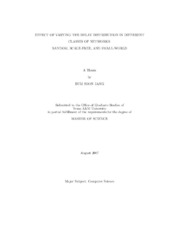| dc.description.abstract | Networks, and associative properties, prevalent in natural and artificial systems have
been investigated extensively. A common method for network analysis is based on
graph theory because graphs naturally represent the relationship between objects
in a network. In this context, three classes of networks are frequently investigated:
random, scale-free, and small-world network. The three classes of networks have been
studied extensively, to find properties and to analyze the structure of each network
type using various measurements. Despite that all real networks have time delays,
researchers relying on graph theory commonly disregarded delay or considered them
only as being homogeneous. Delay cannot be ignored because delay has a critical role
in many types of networks, such as the internet, business networks, and biological
networks. The role and effect of delay, however, are still not clearly understood in
the context of graph-based analysis. Furthermore, graph-based analysis of networks
containing delay has not been attempted so far. In this thesis, I compared multiple
network structures with delay in a graph context. I incorporated delay information
into the network topology by a simple technique called temporal augmentation. Also,
I investigated the effect of varying the delay distribution in these different network
classes with added delay.
In this thesis, several experiments were conducted based on two network construction methods (naive, and modified conventional method) and three types of
delay distributions (peaked, uniform, and unimodal), with different network parameters.
From the experiments, I found that the effect of the number of hubs in scale-free
network was negligible, while the role of neighborhood size in small-world networks
was significant. Also, neighborhood size affect smallworldness of networks.
Effect of delay was expressed differently based on different patterns of delay
distribution and network structures. Networks with uniformly randomly distributed
delay had the best robustness in dealing with delay. Unimodal cases had larger
increases in shortest path sum than uniform case. Peaked cases showed the worst
increase in shortest path sum. Also, sparse networks with high smallworldness was
less affected by delay while dense networks with high smallworldness more affected
by delay. These results extended understanding of the relationship between network
structures and delay. | en |


